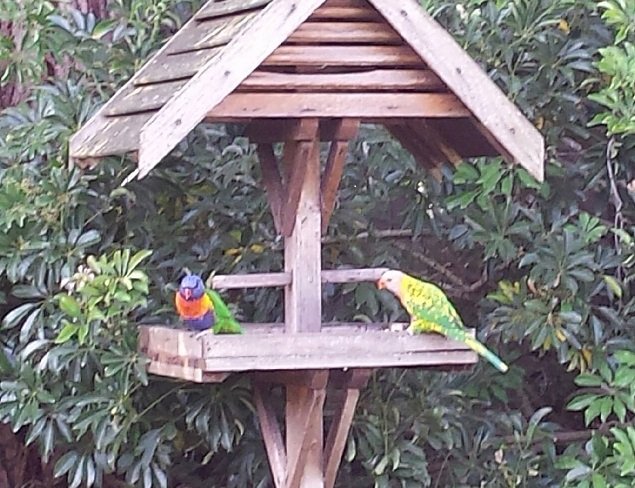This bird frequents my backyard with what appears to be its partner which is a lorrikeet, but the colouring is completely different. Wondered if it is a cross breed (if that is possible) or a mutation. Thanks.
| Term and Conditions | Privacy Statement | Web Support by Gaia Resources Hosted by Serversaurus |  |









It looks like a Rosella because of the long tail and shape in general, if so it is definitely a colour mutation, but I could be wrong, let's wait for the experts!
Tegan - Melbourne Vic.
Given the odd appearance I'd assume it's a hybrid, most likely rainbow lorikeet x scaly-breasted lorikeet which is noted to happen on occasion
i think this a partially leucistic rainbow lorikeet.
mutations are popular in aviculture but this is quite likely a wild bird.
i don't think it's necessarily a hybrid, i've seen plenty of wild scaly x rainbow in melbourne and none have had yellow on the back.
I just saw the patterning and my mind jumped straight to scaly-breasted but yeah doesn't look like it actually. Perhaps it's a cross of an escaped lutino and regular rainbow lorikeet? I guess that could also explain the pale head, although it could be leucistic as well.
Actually looking through a bunch of lorikeet mutations on breedings sites, it looks exactly like a pied rainbow lorikeet with a really pale head
lutinos can also exist as random mutations in wild populations.
there's also a slightly similar fallow mutation rainbow about, though it doesn't have the dark green back.
pied fallow?
She comes in most days. Seems very healthy. The feathers on her head are pure white. Very pretty bird.
From what I've read, the fallow gene won't express in the presence of the pied gene, so pied fallow isn't a likely option (http://www.utopiabirds.com.au/gen%20explan.htm#), although my interpretation might be incorrect. Anyway in that case, if the head feathers are pure white I guess it would most likely be a partially leucistic pied rainbow.
Also afaik, a phenotype mutation altering colouration won't negatively impact the general health of the bird, but rather will make it more noticeable and therefore more susceptible to predation.
Hi there, Muylynda. I note the feeding table for the birds which visit you. You might be interested in the discussion about artificial feeding of birds which occurs from time to time on this forum. Just type <artificial feeding >into the search box near the top of this page.
interesting indeed, amateur.
some of these mutations look like they could be entirely different species plumage wise.
Thanks for that. I was very interested to read the comments on artificial feeding. I have extensive plantings of natives that attract the birds to my garden anyway, so might remove the seed stand M
lorikeets should not be fed dry seed, they are specialised nectar/pollen feeders and their soft brush tongues can be damaged by the hard food items which constitute more conventional parrot fare. sunflower seeds also have a high fat content and overconsumption can result in health issues.
specialised nectar substitutes are fed to the birds in captivity, and some do provide these preparations to wild birds in dispensers, though personally i'd rather they didn't.
Your decision will surely benefit the birds, Muylynda, especially since you have established habitat for them.